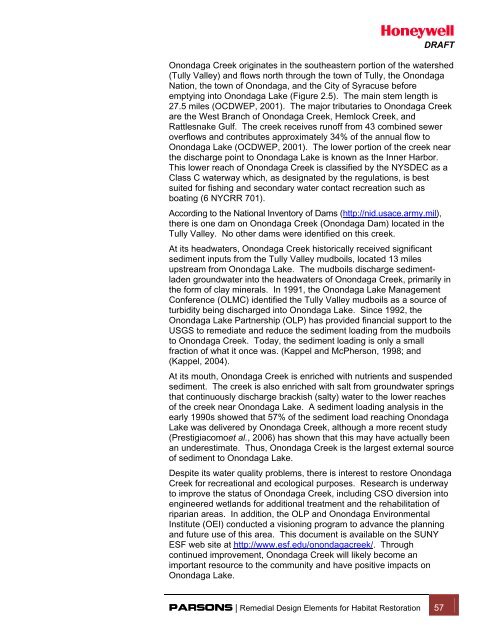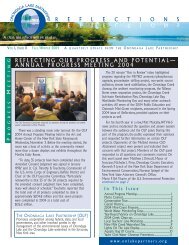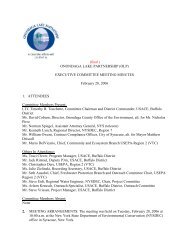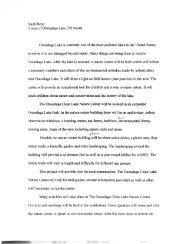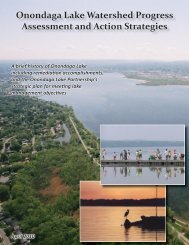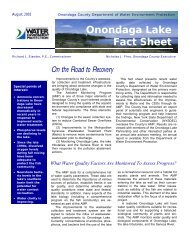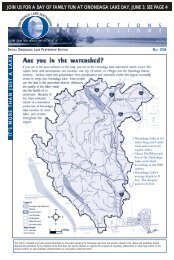Habitat Plan 2 - Onondaga Lake Partnership
Habitat Plan 2 - Onondaga Lake Partnership
Habitat Plan 2 - Onondaga Lake Partnership
Create successful ePaper yourself
Turn your PDF publications into a flip-book with our unique Google optimized e-Paper software.
DRAFT<strong>Onondaga</strong> Creek originates in the southeastern portion of the watershed(Tully Valley) and flows north through the town of Tully, the <strong>Onondaga</strong>Nation, the town of <strong>Onondaga</strong>, and the City of Syracuse beforeemptying into <strong>Onondaga</strong> <strong>Lake</strong> (Figure 2.5). The main stem length is27.5 miles (OCDWEP, 2001). The major tributaries to <strong>Onondaga</strong> Creekare the West Branch of <strong>Onondaga</strong> Creek, Hemlock Creek, andRattlesnake Gulf. The creek receives runoff from 43 combined seweroverflows and contributes approximately 34% of the annual flow to<strong>Onondaga</strong> <strong>Lake</strong> (OCDWEP, 2001). The lower portion of the creek nearthe discharge point to <strong>Onondaga</strong> <strong>Lake</strong> is known as the Inner Harbor.This lower reach of <strong>Onondaga</strong> Creek is classified by the NYSDEC as aClass C waterway which, as designated by the regulations, is bestsuited for fishing and secondary water contact recreation such asboating (6 NYCRR 701).According to the National Inventory of Dams (http://nid.usace.army.mil),there is one dam on <strong>Onondaga</strong> Creek (<strong>Onondaga</strong> Dam) located in theTully Valley. No other dams were identified on this creek.At its headwaters, <strong>Onondaga</strong> Creek historically received significantsediment inputs from the Tully Valley mudboils, located 13 milesupstream from <strong>Onondaga</strong> <strong>Lake</strong>. The mudboils discharge sedimentladengroundwater into the headwaters of <strong>Onondaga</strong> Creek, primarily inthe form of clay minerals. In 1991, the <strong>Onondaga</strong> <strong>Lake</strong> ManagementConference (OLMC) identified the Tully Valley mudboils as a source ofturbidity being discharged into <strong>Onondaga</strong> <strong>Lake</strong>. Since 1992, the<strong>Onondaga</strong> <strong>Lake</strong> <strong>Partnership</strong> (OLP) has provided financial support to theUSGS to remediate and reduce the sediment loading from the mudboilsto <strong>Onondaga</strong> Creek. Today, the sediment loading is only a smallfraction of what it once was. (Kappel and McPherson, 1998; and(Kappel, 2004).At its mouth, <strong>Onondaga</strong> Creek is enriched with nutrients and suspendedsediment. The creek is also enriched with salt from groundwater springsthat continuously discharge brackish (salty) water to the lower reachesof the creek near <strong>Onondaga</strong> <strong>Lake</strong>. A sediment loading analysis in theearly 1990s showed that 57% of the sediment load reaching <strong>Onondaga</strong><strong>Lake</strong> was delivered by <strong>Onondaga</strong> Creek, although a more recent study(Prestigiacomoet al., 2006) has shown that this may have actually beenan underestimate. Thus, <strong>Onondaga</strong> Creek is the largest external sourceof sediment to <strong>Onondaga</strong> <strong>Lake</strong>.Despite its water quality problems, there is interest to restore <strong>Onondaga</strong>Creek for recreational and ecological purposes. Research is underwayto improve the status of <strong>Onondaga</strong> Creek, including CSO diversion intoengineered wetlands for additional treatment and the rehabilitation ofriparian areas. In addition, the OLP and <strong>Onondaga</strong> EnvironmentalInstitute (OEI) conducted a visioning program to advance the planningand future use of this area. This document is available on the SUNYESF web site at http://www.esf.edu/onondagacreek/. Throughcontinued improvement, <strong>Onondaga</strong> Creek will likely become animportant resource to the community and have positive impacts on<strong>Onondaga</strong> <strong>Lake</strong>.PARSONS | Remedial Design Elements for <strong>Habitat</strong> Restoration 57


